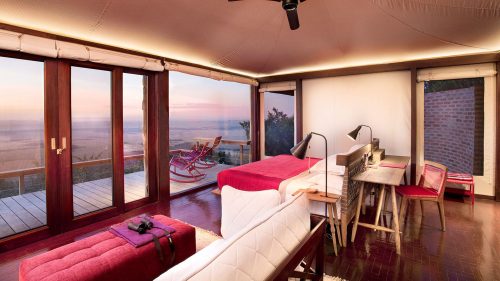
Between the Maasai Mara National Reserve and Amboseli National Park, there is a part of Kenya known as the Southern Great Rift Valley. Here you'll find Shompole Wilderness, a small lodge located in Shompole Conservancy. As a wildlife photographer, I was particularly excited to visit here because the lodge has a special feature — a photographic hide — and I was finally going to experience this for the first time.
One of the unique things about Shompole is that it lies in a semi-arid environment where water is scarce. It is south of Lake Magadi, an alkaline lake that is an infinite source of soda ash which has been harvested in this part of the country for over 100 years. Due to the lack of water, this is the perfect place for a man-made watering hole to support local wildlife — and the ideal place to build a photo hide.
The Shompole Hide is a repurposed shipping container built into the ground, fully fitted with comfortable chairs in front of windows that are eye-level with the water. This allows a person to stay in the same place for hours and spot multiple species of wildlife in the intimate action of both drinking water and interacting with it. With the chances of seeing cats much higher at night, the hide comes with beds, allowing guests the opportunity to sleep while waiting for animals to appear.
Lighting and shutter speed are important in hide photography as a higher shutter speed ensures focus when the animals are moving. To me, hide photography also allows for unique compositions and angles that would otherwise be difficult from a vehicle or even on foot.
Being still and patiently waiting in a hide is quite different from being in a safari vehicle searching for animals. As you sit, the animals slowly approach the water — constantly on high alert — and begin to drink. In the span of only a few hours, we saw more than ten species of animals, large and small. I was only in the hide for a few hours, but even in that short time, it was wonderful to observe this behaviour from a very low angle.
Perhaps one of the most interesting was a giraffe that appeared out of the dust as it timidly approached the water and then retreated several times. It finally came to the edge of the water, widened its stance and gently lowered its head as several ox peckers appeared, flying around to also get some water and a snack from the giraffe itself. After drinking for some time, the giraffe quickly raised its head as water sprayed everywhere and oxpeckers went flying. I have seen this many times in my life but not from this perspective; it was incredible to see the giraffe quite literally towering over us as it went up and down to drink water.
I am fascinated by reflections and find them such an interesting thing to explore in photography as they allow you to enter another world that feels slightly different from ours. The ripples in water show interesting shapes and textures that would not otherwise be captured. A reflection is like a dreamy version of real life with an abstract element and a lack of sharp lines. I really enjoyed playing with the surface of the water as a creative tool to create unique images of wildlife that I wouldn’t normally be able to capture from inside a safari vehicle.
Filed under: East Africa Travel
Subscribe for Weekly Stories
Comments (1):
18 September 2023
Hi Andrew - beautiful photos - especially the Impala reflection Thank you for helping Dex with his photography. We hope to meet you one day soon

Tented Suites